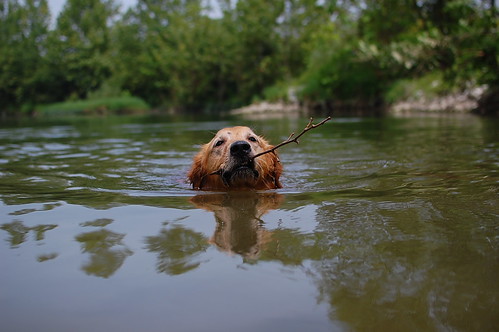An Introduction to Canine Hydrotherapy
Trendy health fads seem to come and go on an almost weekly basis. we always seem to be hearing about the latest, greatest health, fitness or diet regimes that ‘the stars all swear by,’
The trouble with health fads is that they have a tendency to cloud popular opinion of some relatively new or lesser known treatments that actually work.
Canine Hydrotherapy Works.
It is not a fad and many dogs have reason to be grateful for its existence.
What is Hydrotherapy?
Weightless Exercise
Hydrotherapy offers a therapeutic, relaxed and enjoyable workout, which many dogs are deprived of in day to day life, especially through arthritic joints, after an injury or surgery.
Controlled swimming allows muscles to be stimulated and exercised without the stress element associated with land based exercise, causing potential pain.
Vets recommend a course of hydrotherapy for pre- and post-surgical conditioning, to reduce weight in obese animals, for painless exercise for pets with arthritis or dysplasia, cardiovascular workout for seniors, rehabilitation for stroke sufferers, and pain management. It is therefore of use in many orthopaedic conditions both pre-operatively to improve muscle tone to affected limbs (for instance, prior to total hip replacement) and post-operatively to improve repair – for instance in post-operative care of cruciate ligament rupture, osteochondrosis or fracture repair where light swimming can begin as soon as the sutures have been removed.
Preliminary observations suggest that hydrotherapy, if initiated early in the course of disease, can help to maintain muscle tone in cases of degenerative radiculomyelopathy (CDRM) and other neurological diseases with similar presenting signs.
In show dogs and racing dogs, it provides an effective means of maintaining fitness and toning muscle, particularly in the winter months, and is a valuable aid to weight control in the obese pet.
Benefits of Canine Hydrotherapy
Hydrotherapy techniques help to relieve pain and strengthen and re-train muscles; because the animal is effectively weightless when swimming. Hydrotherapy acts by encouraging a full range of joint motion, thus improving muscle tone without imposing undue stress on damaged tissues. This is why results can occur so quickly.
Each hydrotherapy session should be tailored to an individual dog’s condition and fitness level – all dogs should therefore visit through a referral from a veterinary surgeon. An assessment of the dog’s condition will be made and the treatment given at each session recorded. In this way the progress that the dog makes can be monitored. The rate at which such progress is made will be dependent on the breed of dog, condition for which it being treated, age and fitness level.
How Safe is Canine Hydrotherapy?
There are no set dimensions for hydrotherapy pools. What is ideal for a Yorkshire Terrier will be significantly different to that needed by a Newfoundland. All pools should have water heated to a temperature in the range 24 to 300C and should allow all year round operation.
The combination of water and electrical circuitry makes it essential that the operation adheres to strict safety standards.
Malcolm Adler, Company Secretary of the CHA (The Canine Hydrotherapy Association), and a Director at the Hydrozone Therapy Centre in the UK explained: “It is always advisable to visit a hydrotherapy pool before you begin any treatment programme, to inspect the facilities, ask about qualifications and training, check water quality and insurance cover, and discuss your dog’s condition and the treatment programme. The key aspect is quality treatment for your dog.
Typically a session will allow for up to 30 minutes, to include time for drying the dog afterwards. In most centres, owners are encouraged to attend sessions to help reassure their dog during its initial exposure to water”
Further Research…
There is an enormous amount of case history and glowing customer testimonials on the benefits that hydrotherapy has brought to their dog’s condition and overall well-being. However, there is still a lack of formal study and scientific data and one of the aims of the CHA is to promote such work, and the Association welcomes inquiries or contributions from any interested party in this respect.
